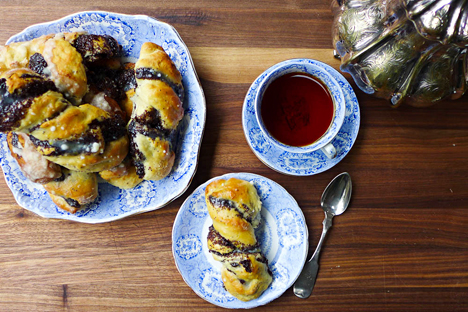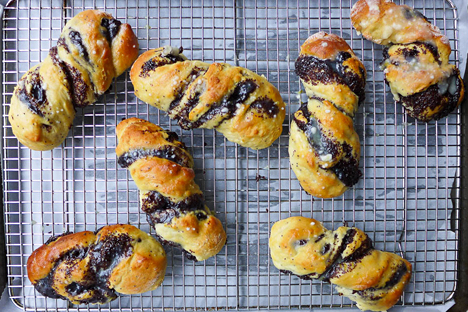
Poppy seed sweet rolls. Source: Jennifer Eremeeva
If I have something like Proust’s madeleine (and everyone should) then poppy seed rolls are it. I associate them with St. Petersburg, where they were, hands down, everyone’s favorite breakfast treat at the Hotel Pribaltiyskaya: a hulking three-star hotel located on the Gulf of Finland.
There is no place colder on God’s earth than the Hotel Pribaltiyskaya on a cold February morning, unless it is Peterhof, and usually at least one of my days as a tour guide involved moving from one to the other and back again.
It was the poppy seed rolls that got me out of bed on those cold winter mornings and down to breakfast, or at least, it was the idea that I had to stand guard over my group’s portion of poppy seed rolls so one of those other tour companies didn’t snatch them.
I had forgotten all about them until I was up in St. Petersburg this autumn during the first real sleet storm of the season. As I elbowed some rather tough types from Pskov out of the way at the somewhat lackluster breakfast buffet at the Hotel Angleterre, I came upon a tray of poppy seed buns, just like those they used to serve at the Pribaltiyskaya. One bite and I was transported back in time, and furnished with enough energy and resolve to walk all the way down Nevsky Prospekt to the new Fabergé Museum in the driving sleet.
Back home in Moscow, I decided I wasn’t going to let poppy seed rolls be relegated to The Remembrance of Things Past, so I cracked open my cookbooks to see if I could achieve the same light, slightly yeasty dough with the sweet, yet almost umami-tasting filling of the poppy seeds.
Poppy seeds are popular in Russia, in both sweet and savory dishes. Throughout Eastern and Central Europe, like in Poland, Hungary, and the Czech Republic, where poppy seeds are plentiful, a rich poppy seed rolled cake or strudel takes center stage in the Christmas confectionary line up.
I experimented long and hard to hit the right balance in my poppy seed rolls, which I quickly decided were more successful as crullers or twists, iced, as were the Pribaltiyskaya buns, with a tangy lemony glaze. A bit of orange extract gave the dough the right flavor, and sweetened, condensed milk provided the consistency and rich, milky flavor I was looking for. So while it’s cold outside, these buns will give us the strength we need to carry on!

Try to cook your own poppy twist! Source: Jennifer Eremeeva
1. Prepare the butter by bringing it to room temperature and slicing the stick into small cubes. Melt the remaining 2 tbsp and coat a large, non-reactive bowl with roughly half of it. Set both aside.
2. Gently heat the milk in a saucepan over medium heat until it is 110℉ and then decant into a glass measuring cup or bowl. Add the 15 ml/1 tbsp of sugar you have kept back, and whisk to combine. Sprinkle the yeast over the milk and gently whisk to combine. Set aside to proof for 5 minutes.
Sweet roll dough
160 ml (2/3 cup) of whole milk;
145 g (1 stick plus 2 tbsp) of unsalted butter;
700 ml (3 cups) of all-purpose flour, with 60 ml/1/4 cup reserved;
2 large eggs, at room temperature;
1 tsp of kosher salt;
1/2 tsp of orange extract;
7 ml (1-3/4 tsp) of active dry yeast (or one package);
45 ml (3 tbsp) of poppy seeds;
75 ml (5 tbsp) of sugar, with 15 ml/1 tbsp set aside;
Poppy seed filling
355 ml (1-1/2 cups) of poppy seeds;
250 ml (1 cup) of sweetened condensed milk;
160 ml (2/3 cup) of dried prunes, loosely chopped;
80 ml (1/3 cup) of finely chopped walnuts (optional);
45 ml (3 tbsp) of grated orange zest;
Lemon glaze
45 ml (3 tbsp) of fresh lemon juice;
5 ml (1 tsp) of lemon extract;
415 ml (1-1/2 cups) of confectioner’s sugar;
Special equipment
A meat grinder or a clean coffee grinder
3. Combine all but the 1/4 cup of flour with the remaining sugar, poppy seeds, and salt in the bowl of a food processor or standing mixer.
4. Whisk the eggs lightly, then add them to the yeast mixture together with the orange extract.
5. Add the yeast mixture to the flour mixture, then process or mix on medium speed until combined (about 2-3 minutes). When the liquids and solids have combined, add the butter, one piece at a time with the mixer running at medium speed, or pulse the processor to combine. Make sure that the butter is thoroughly combined into the dough, and when it is, knead the dough for an additional 5 minutes on medium-high speed until the dough is elastic. If the dough is too sticky (this will depend upon the size of the eggs you use) add some of the additional flour.
6. Scrape the dough into the greased bowl, then coat it with the remaining butter, then cover with plastic wrap and place in a warm, non-drafty place to rise for 1-1/2 hours. You can run the microwave for one moment and then place the bowl inside, taking care to shut the door gently.
7. While the dough is rising, make the poppy seed filling: Rinse the poppy seeds under cold water in a colander. Place them in a pot and cover with cold water. Bring to a simmer, then remove the poppy seeds from the heat, cover, and let sit for 30 minutes. Repeat this step one more time.
8. Drain the poppy seeds, then push them through the grinder, or mill them in small batches through the coffee grinder. Then combine the poppy seeds and the remaining ingredients in a food processor, fitted with a steel blade and process until smooth. You can make this ahead of time and keep in a non-reactive container with a lid in the refrigerator.
9. When the dough has risen to at least twice its size, punch it down, then sprinkle 2 tbsp of flour on top of the dough. Knead it gently to loosen it, then turn it onto a cool, floured surface.
10. Roll the dough into a rectangle, then smear the poppy seed filling onto all but the outermost inch of the surface of the dough.
11. Brush the edges of the dough with cold water, then roll the rectangle into a tight log. Place the log onto a cookie sheet, covered in parchment paper, cover with plastic wrap and set in a warm, non-drafty place to rise another 1 hour.
12. Preheat the oven to 190℃/350℉.
13. When the dough has risen, remove it from the cookie sheet onto a cutting board, lightly sprinkled with flour. Cut the log into 1-1/2 centimeter or 3/4-inch disks. Twist each disk into the shape of a cruller and place it on the cookie sheet, leaving plenty of room between them.
14. Bake the poppy seed twists for twenty minutes.
15. While the twists are cooking, assemble the glaze by combining the ingredients in a glass measuring cup and processing in the microwave for 30 seconds, then whisking vigorously with a fork.
16. Pipe or brush the glaze on to the twists as they are cooling on a rack.
Happy Holidays!
Jennifer Eremeeva is an American writer who has called Moscow home for twenty years. She is the author of Lenin Lives Next Door: Marriage, Martinis, and Mayhem in Moscow and Have Personality Disorder, Will Rule Russia: A Concise History of Russia. She writes about Russian history, culture, everyday life and humor, and food at http://jennifereremeeva.com.
All rights reserved by Rossiyskaya Gazeta.
Subscribe
to our newsletter!
Get the week's best stories straight to your inbox